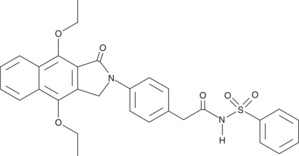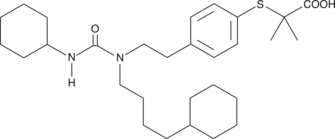Chemicals
Showing 21451–21600 of 41137 results
-
Guanosine is a purine nucleoside that is comprised of the purine base guanine attached to a ribose moiety.{46175} Mono-, di-, tri-, and cyclic monophosphorylated forms of guanosine (GMP, GDP, GTP, and cGMP, respectively) are essential for a variety of endogenous biochemical processes, such as signal transduction, metabolism, and RNA synthesis.{26065,1257,26064}
Brand:CaymanSKU:27702 - 25 gAvailable on backorder
Guanosine is a purine nucleoside that is comprised of the purine base guanine attached to a ribose moiety.{46175} Mono-, di-, tri-, and cyclic monophosphorylated forms of guanosine (GMP, GDP, GTP, and cGMP, respectively) are essential for a variety of endogenous biochemical processes, such as signal transduction, metabolism, and RNA synthesis.{26065,1257,26064}
Brand:CaymanSKU:27702 - 5 gAvailable on backorder
Guanosine 5′-triphosphate (GTP) acts as a substrate for the synthesis of RNA during the transcription process and the synthesis of DNA during DNA replication.{26064} It is generated by the citric acid cycle and provides a source of energy for protein synthesis and gluconeogenesis, activating substrates in metabolic reactions.{26065} GTP is essential for G protein-related signal transduction in second-messenger mechanisms where it is converted to GDP through the action of GTPases.{1257}
Brand:CaymanSKU:-Guanosine 5′-triphosphate (GTP) acts as a substrate for the synthesis of RNA during the transcription process and the synthesis of DNA during DNA replication.{26064} It is generated by the citric acid cycle and provides a source of energy for protein synthesis and gluconeogenesis, activating substrates in metabolic reactions.{26065} GTP is essential for G protein-related signal transduction in second-messenger mechanisms where it is converted to GDP through the action of GTPases.{1257}
Brand:CaymanSKU:-Guanosine 5′-triphosphate (GTP) acts as a substrate for the synthesis of RNA during the transcription process and the synthesis of DNA during DNA replication.{26064} It is generated by the citric acid cycle and provides a source of energy for protein synthesis and gluconeogenesis, activating substrates in metabolic reactions.{26065} GTP is essential for G protein-related signal transduction in second-messenger mechanisms where it is converted to GDP through the action of GTPases.{1257}
Brand:CaymanSKU:-Guanosine 5′-triphosphate (GTP) acts as a substrate for the synthesis of RNA during the transcription process and the synthesis of DNA during DNA replication.{26064} It is generated by the citric acid cycle and provides a source of energy for protein synthesis and gluconeogenesis, activating substrates in metabolic reactions.{26065} GTP is essential for G protein-related signal transduction in second-messenger mechanisms where it is converted to GDP through the action of GTPases.{1257}
Brand:CaymanSKU:-Guanylyl imidodiphosphate is a nonhydrolyzable analog of GTP that can bind to and irreversibly activate G proteins in the presence of Mg2+.{27512} This nucleotide is a potent stimulator of adenylate cyclase.{27510} Guanylyl imidodiphosphate is used in studies of protein synthesis since the process of GTP binding, hydrolysis, and release is essential for the initiation of protein translocation across the endoplasmic reticulum.{27511}
Brand:CaymanSKU:-Out of stock
Guanylyl imidodiphosphate is a nonhydrolyzable analog of GTP that can bind to and irreversibly activate G proteins in the presence of Mg2+.{27512} This nucleotide is a potent stimulator of adenylate cyclase.{27510} Guanylyl imidodiphosphate is used in studies of protein synthesis since the process of GTP binding, hydrolysis, and release is essential for the initiation of protein translocation across the endoplasmic reticulum.{27511}
Brand:CaymanSKU:-Out of stock
Guanylyl imidodiphosphate is a nonhydrolyzable analog of GTP that can bind to and irreversibly activate G proteins in the presence of Mg2+.{27512} This nucleotide is a potent stimulator of adenylate cyclase.{27510} Guanylyl imidodiphosphate is used in studies of protein synthesis since the process of GTP binding, hydrolysis, and release is essential for the initiation of protein translocation across the endoplasmic reticulum.{27511}
Brand:CaymanSKU:-Out of stock
Guanylyl imidodiphosphate is a nonhydrolyzable analog of GTP that can bind to and irreversibly activate G proteins in the presence of Mg2+.{27512} This nucleotide is a potent stimulator of adenylate cyclase.{27510} Guanylyl imidodiphosphate is used in studies of protein synthesis since the process of GTP binding, hydrolysis, and release is essential for the initiation of protein translocation across the endoplasmic reticulum.{27511}
Brand:CaymanSKU:-Out of stock
Gue1654 is a Gβγ-signaling-biased 5-OxoETE receptor antagonist.{46628} It inhibits neutrophil and eosinophil shape change and chemotaxis induced by 5-OxoETE (Item No. 34250) but not chemoattractant C5a or prostaglandin D2 (PGD2; Item No. 12010). Gue1654 inhibits 5-OxoETE-induced Gβγ-mediated inositol monophosphate (IP1) production in HEK293 cells transiently expressing the 5-OxoETE receptor, an effect that can be blocked by the Gβγ-inhibitor gallein, but has no effect on IP1 production induced by stimulation of endogenous Gαq-linked muscarinic receptors. In a bioluminescence resonance energy transfer (BRET) assay, Gue1654 reduces the 5-OxoETE-induced, but not basal, BRET fluorescence response, indicating disruption of the interaction between ligand-activated 5-OxoETE receptor and Gβγ.
Brand:CaymanSKU:29686 - 1 mgAvailable on backorder
Gue1654 is a Gβγ-signaling-biased 5-OxoETE receptor antagonist.{46628} It inhibits neutrophil and eosinophil shape change and chemotaxis induced by 5-OxoETE (Item No. 34250) but not chemoattractant C5a or prostaglandin D2 (PGD2; Item No. 12010). Gue1654 inhibits 5-OxoETE-induced Gβγ-mediated inositol monophosphate (IP1) production in HEK293 cells transiently expressing the 5-OxoETE receptor, an effect that can be blocked by the Gβγ-inhibitor gallein, but has no effect on IP1 production induced by stimulation of endogenous Gαq-linked muscarinic receptors. In a bioluminescence resonance energy transfer (BRET) assay, Gue1654 reduces the 5-OxoETE-induced, but not basal, BRET fluorescence response, indicating disruption of the interaction between ligand-activated 5-OxoETE receptor and Gβγ.
Brand:CaymanSKU:29686 - 10 mgAvailable on backorder
Gue1654 is a Gβγ-signaling-biased 5-OxoETE receptor antagonist.{46628} It inhibits neutrophil and eosinophil shape change and chemotaxis induced by 5-OxoETE (Item No. 34250) but not chemoattractant C5a or prostaglandin D2 (PGD2; Item No. 12010). Gue1654 inhibits 5-OxoETE-induced Gβγ-mediated inositol monophosphate (IP1) production in HEK293 cells transiently expressing the 5-OxoETE receptor, an effect that can be blocked by the Gβγ-inhibitor gallein, but has no effect on IP1 production induced by stimulation of endogenous Gαq-linked muscarinic receptors. In a bioluminescence resonance energy transfer (BRET) assay, Gue1654 reduces the 5-OxoETE-induced, but not basal, BRET fluorescence response, indicating disruption of the interaction between ligand-activated 5-OxoETE receptor and Gβγ.
Brand:CaymanSKU:29686 - 25 mgAvailable on backorder
Gue1654 is a Gβγ-signaling-biased 5-OxoETE receptor antagonist.{46628} It inhibits neutrophil and eosinophil shape change and chemotaxis induced by 5-OxoETE (Item No. 34250) but not chemoattractant C5a or prostaglandin D2 (PGD2; Item No. 12010). Gue1654 inhibits 5-OxoETE-induced Gβγ-mediated inositol monophosphate (IP1) production in HEK293 cells transiently expressing the 5-OxoETE receptor, an effect that can be blocked by the Gβγ-inhibitor gallein, but has no effect on IP1 production induced by stimulation of endogenous Gαq-linked muscarinic receptors. In a bioluminescence resonance energy transfer (BRET) assay, Gue1654 reduces the 5-OxoETE-induced, but not basal, BRET fluorescence response, indicating disruption of the interaction between ligand-activated 5-OxoETE receptor and Gβγ.
Brand:CaymanSKU:29686 - 5 mgAvailable on backorder
Guvacine is an amino acid found in A. catechu (Betel nut).{36158} It competitively inhibits GABA uptake (IC50 = 10 μM; Ki = 14 μM) in rat hippocampal brain slices.{36158,36159} In vivo, guvacine, at doses ranging from 50-100 mg/kg, decreases spontaneous activity in mice.{36158} Administration of guvacine also decreases tail flick reaction time in a rat model of morphine analgesia.{36160}
Brand:CaymanSKU:23361 - 100 mgAvailable on backorder
Guvacine is an amino acid found in A. catechu (Betel nut).{36158} It competitively inhibits GABA uptake (IC50 = 10 μM; Ki = 14 μM) in rat hippocampal brain slices.{36158,36159} In vivo, guvacine, at doses ranging from 50-100 mg/kg, decreases spontaneous activity in mice.{36158} Administration of guvacine also decreases tail flick reaction time in a rat model of morphine analgesia.{36160}
Brand:CaymanSKU:23361 - 25 mgAvailable on backorder
Guvacine is an amino acid found in A. catechu (Betel nut).{36158} It competitively inhibits GABA uptake (IC50 = 10 μM; Ki = 14 μM) in rat hippocampal brain slices.{36158,36159} In vivo, guvacine, at doses ranging from 50-100 mg/kg, decreases spontaneous activity in mice.{36158} Administration of guvacine also decreases tail flick reaction time in a rat model of morphine analgesia.{36160}
Brand:CaymanSKU:23361 - 250 mgAvailable on backorder
Guvacine is an amino acid found in A. catechu (Betel nut).{36158} It competitively inhibits GABA uptake (IC50 = 10 μM; Ki = 14 μM) in rat hippocampal brain slices.{36158,36159} In vivo, guvacine, at doses ranging from 50-100 mg/kg, decreases spontaneous activity in mice.{36158} Administration of guvacine also decreases tail flick reaction time in a rat model of morphine analgesia.{36160}
Brand:CaymanSKU:23361 - 50 mgAvailable on backorder
Guvacoline is a natural alkaloid found in areca nuts that is related to the nootropic, arecoline (Item No. 13662). Guvacoline can act as a full agonist of atrial and ileal muscarinic receptors, although at 15-fold reduced potency compared to arecoline.{28111} The metabolomics and toxicity of this compound have been reported.{28112,28113}
Brand:CaymanSKU:-Out of stock
Guvacoline is a natural alkaloid found in areca nuts that is related to the nootropic, arecoline (Item No. 13662). Guvacoline can act as a full agonist of atrial and ileal muscarinic receptors, although at 15-fold reduced potency compared to arecoline.{28111} The metabolomics and toxicity of this compound have been reported.{28112,28113}
Brand:CaymanSKU:-Out of stock
Guvacoline is a natural alkaloid found in areca nuts that is related to the nootropic, arecoline (Item No. 13662). Guvacoline can act as a full agonist of atrial and ileal muscarinic receptors, although at 15-fold reduced potency compared to arecoline.{28111} The metabolomics and toxicity of this compound have been reported.{28112,28113}
Brand:CaymanSKU:-Out of stock
The transcription factor peroxisome proliferator-activated receptor δ (PPARδ) is a member of the superfamily of nuclear hormone receptors and is implicated both in lipid metabolism and in the regulation of genes with potential roles in neurotoxicity. GW 0742 is a selective PPARδ agonist (EC50 = 1.1 nM) that exhibits 1,000-fold selectivity over the other human PPAR subtypes.{11580} GW 0742 exhibits time-dependent neuroprotection in low KCl-induced apoptosis in cerebellar granule neuronal cultures. Despite the neuroprotective properties observed, prolonged (48h) incubation with GW 0742 produced significant inherent toxicity. This cell death was determined to be apoptotic as identified with the TUNEL assay.{14765}
Brand:CaymanSKU:10006798 - 10 mgAvailable on backorder
The transcription factor peroxisome proliferator-activated receptor δ (PPARδ) is a member of the superfamily of nuclear hormone receptors and is implicated both in lipid metabolism and in the regulation of genes with potential roles in neurotoxicity. GW 0742 is a selective PPARδ agonist (EC50 = 1.1 nM) that exhibits 1,000-fold selectivity over the other human PPAR subtypes.{11580} GW 0742 exhibits time-dependent neuroprotection in low KCl-induced apoptosis in cerebellar granule neuronal cultures. Despite the neuroprotective properties observed, prolonged (48h) incubation with GW 0742 produced significant inherent toxicity. This cell death was determined to be apoptotic as identified with the TUNEL assay.{14765}
Brand:CaymanSKU:10006798 - 25 mgAvailable on backorder
The transcription factor peroxisome proliferator-activated receptor δ (PPARδ) is a member of the superfamily of nuclear hormone receptors and is implicated both in lipid metabolism and in the regulation of genes with potential roles in neurotoxicity. GW 0742 is a selective PPARδ agonist (EC50 = 1.1 nM) that exhibits 1,000-fold selectivity over the other human PPAR subtypes.{11580} GW 0742 exhibits time-dependent neuroprotection in low KCl-induced apoptosis in cerebellar granule neuronal cultures. Despite the neuroprotective properties observed, prolonged (48h) incubation with GW 0742 produced significant inherent toxicity. This cell death was determined to be apoptotic as identified with the TUNEL assay.{14765}
Brand:CaymanSKU:10006798 - 5 mgAvailable on backorder
The transcription factor peroxisome proliferator-activated receptor δ (PPARδ) is a member of the superfamily of nuclear hormone receptors and is implicated both in lipid metabolism and in the regulation of genes with potential roles in neurotoxicity. GW 0742 is a selective PPARδ agonist (EC50 = 1.1 nM) that exhibits 1,000-fold selectivity over the other human PPAR subtypes.{11580} GW 0742 exhibits time-dependent neuroprotection in low KCl-induced apoptosis in cerebellar granule neuronal cultures. Despite the neuroprotective properties observed, prolonged (48h) incubation with GW 0742 produced significant inherent toxicity. This cell death was determined to be apoptotic as identified with the TUNEL assay.{14765}
Brand:CaymanSKU:10006798 - 50 mgAvailable on backorder
GPR40 (free fatty acid receptor 1; FFAR1) is a G protein-coupled receptor (GPCR) that is activated by saturated and unsaturated long chain fatty acids. It is thought to play a role in the potentiation of insulin secretion by fatty acids in a glucose-sensitive manner. GW 1100 is a selective antagonist of GPR40-mediated Ca2+ elevations in HEK293 cells stimulated by GW 9508 (an agonist of both GPR40 and GPR120 (FFAR4), another GPCR activated by long chain fatty acids) or linoleic acid with a pIC50 value equal to 5.99. However at concentrations up to 10 μM, GW 1100 has no effect on GPR120-mediated stimulation of intracellular Ca2+ release induced by either GW 9508 or linoleic acid.{14194} In the MIN6 mouse insulinoma cell line, 1 μM GW 1100 inhibits the potentiating effects of GW 9508 and linoleic acid on glucose-stimulated insulin secretion.{14194}
Brand:CaymanSKU:10008908 - 10 mgAvailable on backorder
GPR40 (free fatty acid receptor 1; FFAR1) is a G protein-coupled receptor (GPCR) that is activated by saturated and unsaturated long chain fatty acids. It is thought to play a role in the potentiation of insulin secretion by fatty acids in a glucose-sensitive manner. GW 1100 is a selective antagonist of GPR40-mediated Ca2+ elevations in HEK293 cells stimulated by GW 9508 (an agonist of both GPR40 and GPR120 (FFAR4), another GPCR activated by long chain fatty acids) or linoleic acid with a pIC50 value equal to 5.99. However at concentrations up to 10 μM, GW 1100 has no effect on GPR120-mediated stimulation of intracellular Ca2+ release induced by either GW 9508 or linoleic acid.{14194} In the MIN6 mouse insulinoma cell line, 1 μM GW 1100 inhibits the potentiating effects of GW 9508 and linoleic acid on glucose-stimulated insulin secretion.{14194}
Brand:CaymanSKU:10008908 - 25 mgAvailable on backorder
GPR40 (free fatty acid receptor 1; FFAR1) is a G protein-coupled receptor (GPCR) that is activated by saturated and unsaturated long chain fatty acids. It is thought to play a role in the potentiation of insulin secretion by fatty acids in a glucose-sensitive manner. GW 1100 is a selective antagonist of GPR40-mediated Ca2+ elevations in HEK293 cells stimulated by GW 9508 (an agonist of both GPR40 and GPR120 (FFAR4), another GPCR activated by long chain fatty acids) or linoleic acid with a pIC50 value equal to 5.99. However at concentrations up to 10 μM, GW 1100 has no effect on GPR120-mediated stimulation of intracellular Ca2+ release induced by either GW 9508 or linoleic acid.{14194} In the MIN6 mouse insulinoma cell line, 1 μM GW 1100 inhibits the potentiating effects of GW 9508 and linoleic acid on glucose-stimulated insulin secretion.{14194}
Brand:CaymanSKU:10008908 - 5 mgAvailable on backorder
GPR40 (free fatty acid receptor 1; FFAR1) is a G protein-coupled receptor (GPCR) that is activated by saturated and unsaturated long chain fatty acids. It is thought to play a role in the potentiation of insulin secretion by fatty acids in a glucose-sensitive manner. GW 1100 is a selective antagonist of GPR40-mediated Ca2+ elevations in HEK293 cells stimulated by GW 9508 (an agonist of both GPR40 and GPR120 (FFAR4), another GPCR activated by long chain fatty acids) or linoleic acid with a pIC50 value equal to 5.99. However at concentrations up to 10 μM, GW 1100 has no effect on GPR120-mediated stimulation of intracellular Ca2+ release induced by either GW 9508 or linoleic acid.{14194} In the MIN6 mouse insulinoma cell line, 1 μM GW 1100 inhibits the potentiating effects of GW 9508 and linoleic acid on glucose-stimulated insulin secretion.{14194}
Brand:CaymanSKU:10008908 - 50 mgAvailable on backorder
Peroxisome proliferator-activated receptor (PPAR) γ is a nuclear receptor that, when activated, regulates fatty acid storage and glucose metabolism.{15751} The best known class of PPARγ ligands are the thiazolidinediones, including troglitazone (Item No. 71750) and rosiglitazone (Item No. 71740).{8461} GW 1929 is a non-thiazolidinedione activator of PPARγ that binds with a Ki value of 1.4 nM, with greater than 1,000-fold selectivity over other PPAR subtypes.{25251} It has anti-hyperglycemic and anti-hyperlipidemic activity when given orally in mouse and rat models of type 2 diabetes.{25251,25253} Both in vitro and in vivo effects of GW 1929 on PPARγ greatly exceed those produced by troglitazone.{25251,25253} In addition, GW 1929 has neuroprotective effects in global cerebral ischemic-reperfusion injury that are related to reduced inflammation and apoptotic DNA fragmentation.{25252}
Brand:CaymanSKU:-Peroxisome proliferator-activated receptor (PPAR) γ is a nuclear receptor that, when activated, regulates fatty acid storage and glucose metabolism.{15751} The best known class of PPARγ ligands are the thiazolidinediones, including troglitazone (Item No. 71750) and rosiglitazone (Item No. 71740).{8461} GW 1929 is a non-thiazolidinedione activator of PPARγ that binds with a Ki value of 1.4 nM, with greater than 1,000-fold selectivity over other PPAR subtypes.{25251} It has anti-hyperglycemic and anti-hyperlipidemic activity when given orally in mouse and rat models of type 2 diabetes.{25251,25253} Both in vitro and in vivo effects of GW 1929 on PPARγ greatly exceed those produced by troglitazone.{25251,25253} In addition, GW 1929 has neuroprotective effects in global cerebral ischemic-reperfusion injury that are related to reduced inflammation and apoptotic DNA fragmentation.{25252}
Brand:CaymanSKU:-Peroxisome proliferator-activated receptor (PPAR) γ is a nuclear receptor that, when activated, regulates fatty acid storage and glucose metabolism.{15751} The best known class of PPARγ ligands are the thiazolidinediones, including troglitazone (Item No. 71750) and rosiglitazone (Item No. 71740).{8461} GW 1929 is a non-thiazolidinedione activator of PPARγ that binds with a Ki value of 1.4 nM, with greater than 1,000-fold selectivity over other PPAR subtypes.{25251} It has anti-hyperglycemic and anti-hyperlipidemic activity when given orally in mouse and rat models of type 2 diabetes.{25251,25253} Both in vitro and in vivo effects of GW 1929 on PPARγ greatly exceed those produced by troglitazone.{25251,25253} In addition, GW 1929 has neuroprotective effects in global cerebral ischemic-reperfusion injury that are related to reduced inflammation and apoptotic DNA fragmentation.{25252}
Brand:CaymanSKU:-Peroxisome proliferator-activated receptor (PPAR) γ is a nuclear receptor that, when activated, regulates fatty acid storage and glucose metabolism.{15751} The best known class of PPARγ ligands are the thiazolidinediones, including troglitazone (Item No. 71750) and rosiglitazone (Item No. 71740).{8461} GW 1929 is a non-thiazolidinedione activator of PPARγ that binds with a Ki value of 1.4 nM, with greater than 1,000-fold selectivity over other PPAR subtypes.{25251} It has anti-hyperglycemic and anti-hyperlipidemic activity when given orally in mouse and rat models of type 2 diabetes.{25251,25253} Both in vitro and in vivo effects of GW 1929 on PPARγ greatly exceed those produced by troglitazone.{25251,25253} In addition, GW 1929 has neuroprotective effects in global cerebral ischemic-reperfusion injury that are related to reduced inflammation and apoptotic DNA fragmentation.{25252}
Brand:CaymanSKU:-cFMS kinase is the cellular homolog of the v-FMS oncogene product of the Susan McDonough strain of the feline sarcoma virus. It can autophosphorlyate colony-stimulating factor (CSF-1), which promotes the survival, proliferation, and differentiation of mononuclear phagocytes. GW 2580 selectively inhibits cFMS kinase (IC50 = 0.03 μM), preventing CSF-1-induced monocyte growth with an IC50 value of 0.14 μM.{25081} At 75-100 mg/kg, it has been shown to inhibit joint connective tissue and bone degradation in mouse models of arthritis.{25081}
Brand:CaymanSKU:-cFMS kinase is the cellular homolog of the v-FMS oncogene product of the Susan McDonough strain of the feline sarcoma virus. It can autophosphorlyate colony-stimulating factor (CSF-1), which promotes the survival, proliferation, and differentiation of mononuclear phagocytes. GW 2580 selectively inhibits cFMS kinase (IC50 = 0.03 μM), preventing CSF-1-induced monocyte growth with an IC50 value of 0.14 μM.{25081} At 75-100 mg/kg, it has been shown to inhibit joint connective tissue and bone degradation in mouse models of arthritis.{25081}
Brand:CaymanSKU:-cFMS kinase is the cellular homolog of the v-FMS oncogene product of the Susan McDonough strain of the feline sarcoma virus. It can autophosphorlyate colony-stimulating factor (CSF-1), which promotes the survival, proliferation, and differentiation of mononuclear phagocytes. GW 2580 selectively inhibits cFMS kinase (IC50 = 0.03 μM), preventing CSF-1-induced monocyte growth with an IC50 value of 0.14 μM.{25081} At 75-100 mg/kg, it has been shown to inhibit joint connective tissue and bone degradation in mouse models of arthritis.{25081}
Brand:CaymanSKU:-cFMS kinase is the cellular homolog of the v-FMS oncogene product of the Susan McDonough strain of the feline sarcoma virus. It can autophosphorlyate colony-stimulating factor (CSF-1), which promotes the survival, proliferation, and differentiation of mononuclear phagocytes. GW 2580 selectively inhibits cFMS kinase (IC50 = 0.03 μM), preventing CSF-1-induced monocyte growth with an IC50 value of 0.14 μM.{25081} At 75-100 mg/kg, it has been shown to inhibit joint connective tissue and bone degradation in mouse models of arthritis.{25081}
Brand:CaymanSKU:-GW 311616A is an inhibitor of neutrophil elastase (Ki = 0.31 nM).{45465} It is selective for human neutrophil elastase (IC50 = 22 nM) over trypsin, cathepsin G, and plasmin (IC50s = >100 µM for all), as well as chymotrypsin and tissue plasminogen activator (IC50s = >3 µM for all), in a cell-free assay. GW 311616A inhibits neutrophil elastase activity in isolated dog whole blood and in the liver in a mouse model of liver ischemia-reperfusion injury when administered at a dose of 2 mg/kg.{45465},{45466}
Brand:CaymanSKU:27957 - 1 mgAvailable on backorder
GW 311616A is an inhibitor of neutrophil elastase (Ki = 0.31 nM).{45465} It is selective for human neutrophil elastase (IC50 = 22 nM) over trypsin, cathepsin G, and plasmin (IC50s = >100 µM for all), as well as chymotrypsin and tissue plasminogen activator (IC50s = >3 µM for all), in a cell-free assay. GW 311616A inhibits neutrophil elastase activity in isolated dog whole blood and in the liver in a mouse model of liver ischemia-reperfusion injury when administered at a dose of 2 mg/kg.{45465},{45466}
Brand:CaymanSKU:27957 - 10 mgAvailable on backorder
GW 311616A is an inhibitor of neutrophil elastase (Ki = 0.31 nM).{45465} It is selective for human neutrophil elastase (IC50 = 22 nM) over trypsin, cathepsin G, and plasmin (IC50s = >100 µM for all), as well as chymotrypsin and tissue plasminogen activator (IC50s = >3 µM for all), in a cell-free assay. GW 311616A inhibits neutrophil elastase activity in isolated dog whole blood and in the liver in a mouse model of liver ischemia-reperfusion injury when administered at a dose of 2 mg/kg.{45465},{45466}
Brand:CaymanSKU:27957 - 5 mgAvailable on backorder
The liver X receptors, LXRα and LXRβ, are nuclear receptors that act as ligand-dependent transcription factors.{24819} They modulate cholesterol, fatty acids, and glucose homeostasis. GW 3965 is an orally-active agonist of LXRα and LXRβ, activating the human isoforms with EC50 values of 190 and 30 nM, respectively.{10881} It alters LXR-regulated gene expression in mice and rats, affecting pathways related to glucose and lipid metabolism.{10881,24822,24821} GW 3965 also affects inflammation and pressor responses through LXRα and LXRβ.{10880,24823,24820}
Brand:CaymanSKU:10054 - 1 mgAvailable on backorder
The liver X receptors, LXRα and LXRβ, are nuclear receptors that act as ligand-dependent transcription factors.{24819} They modulate cholesterol, fatty acids, and glucose homeostasis. GW 3965 is an orally-active agonist of LXRα and LXRβ, activating the human isoforms with EC50 values of 190 and 30 nM, respectively.{10881} It alters LXR-regulated gene expression in mice and rats, affecting pathways related to glucose and lipid metabolism.{10881,24822,24821} GW 3965 also affects inflammation and pressor responses through LXRα and LXRβ.{10880,24823,24820}
Brand:CaymanSKU:10054 - 10 mgAvailable on backorder
The liver X receptors, LXRα and LXRβ, are nuclear receptors that act as ligand-dependent transcription factors.{24819} They modulate cholesterol, fatty acids, and glucose homeostasis. GW 3965 is an orally-active agonist of LXRα and LXRβ, activating the human isoforms with EC50 values of 190 and 30 nM, respectively.{10881} It alters LXR-regulated gene expression in mice and rats, affecting pathways related to glucose and lipid metabolism.{10881,24822,24821} GW 3965 also affects inflammation and pressor responses through LXRα and LXRβ.{10880,24823,24820}
Brand:CaymanSKU:10054 - 5 mgAvailable on backorder
GW 405833 is a partial agonist of the cannabinoid CB2 receptor (EC50 = 0.65 nM).{16338} It is selective for CB2, binding with a Ki value of 14 nM compared to that of CB1 with a Ki value of 2.04 µM.{16338} GW 405833 demonstrates anti-inflammatory and antihyperalgesic properties in animal models of inflammation and pain.{16338}
Brand:CaymanSKU:20219 -Available on backorder
GW 405833 is a partial agonist of the cannabinoid CB2 receptor (EC50 = 0.65 nM).{16338} It is selective for CB2, binding with a Ki value of 14 nM compared to that of CB1 with a Ki value of 2.04 µM.{16338} GW 405833 demonstrates anti-inflammatory and antihyperalgesic properties in animal models of inflammation and pain.{16338}
Brand:CaymanSKU:20219 -Available on backorder
GW 405833 is a partial agonist of the cannabinoid CB2 receptor (EC50 = 0.65 nM).{16338} It is selective for CB2, binding with a Ki value of 14 nM compared to that of CB1 with a Ki value of 2.04 µM.{16338} GW 405833 demonstrates anti-inflammatory and antihyperalgesic properties in animal models of inflammation and pain.{16338}
Brand:CaymanSKU:20219 -Available on backorder
GW 405833 is a partial agonist of the cannabinoid CB2 receptor (EC50 = 0.65 nM).{16338} It is selective for CB2, binding with a Ki value of 14 nM compared to that of CB1 with a Ki value of 2.04 µM.{16338} GW 405833 demonstrates anti-inflammatory and antihyperalgesic properties in animal models of inflammation and pain.{16338}
Brand:CaymanSKU:20219 -Available on backorder
Farnesoid X receptor (FXR) is a nuclear receptor that acts as a bile acid sensor, protecting cells and organs against bile acid toxicity.{15284} GW 4064 is a selective agonist of FXR (EC50 = 15 nM).{12563} It displays no activity at other nuclear receptors, including the retinoic acid receptor, at concentrations up to 1 μM.{12563} GW 4064 is used to elucidate the role of FXR in dyslipidemia, diabetes, obesity, and cancer.{25476,25477,25475,25474,25473}
Brand:CaymanSKU:10006611 - 1 mgAvailable on backorder
Farnesoid X receptor (FXR) is a nuclear receptor that acts as a bile acid sensor, protecting cells and organs against bile acid toxicity.{15284} GW 4064 is a selective agonist of FXR (EC50 = 15 nM).{12563} It displays no activity at other nuclear receptors, including the retinoic acid receptor, at concentrations up to 1 μM.{12563} GW 4064 is used to elucidate the role of FXR in dyslipidemia, diabetes, obesity, and cancer.{25476,25477,25475,25474,25473}
Brand:CaymanSKU:10006611 - 10 mgAvailable on backorder
Farnesoid X receptor (FXR) is a nuclear receptor that acts as a bile acid sensor, protecting cells and organs against bile acid toxicity.{15284} GW 4064 is a selective agonist of FXR (EC50 = 15 nM).{12563} It displays no activity at other nuclear receptors, including the retinoic acid receptor, at concentrations up to 1 μM.{12563} GW 4064 is used to elucidate the role of FXR in dyslipidemia, diabetes, obesity, and cancer.{25476,25477,25475,25474,25473}
Brand:CaymanSKU:10006611 - 5 mgAvailable on backorder
The high affinity nerve growth factor (NGF) receptor, also known as NGF tyrosine kinase receptor A (TrkA), is involved in the development and maturation of the nervous system. Aberrant expression is associated with certain forms of cancer and congenital insensitivity to pain with anhidrosis.{27678,27676} GW 441756 is a potent inhibitor of TrkA (IC50 = 2 nM).{27675} It displays >100-fold selectivity over a panel of related kinases.{27675} GW 441756 has been used to clarify the role of TrkA in regulating gene expression in neuroblastoma cells and, more recently, in amyloid-β protein precursor cleavage in neuroglioma cells.{27677,27674}
Brand:CaymanSKU:-Out of stock
The high affinity nerve growth factor (NGF) receptor, also known as NGF tyrosine kinase receptor A (TrkA), is involved in the development and maturation of the nervous system. Aberrant expression is associated with certain forms of cancer and congenital insensitivity to pain with anhidrosis.{27678,27676} GW 441756 is a potent inhibitor of TrkA (IC50 = 2 nM).{27675} It displays >100-fold selectivity over a panel of related kinases.{27675} GW 441756 has been used to clarify the role of TrkA in regulating gene expression in neuroblastoma cells and, more recently, in amyloid-β protein precursor cleavage in neuroglioma cells.{27677,27674}
Brand:CaymanSKU:-Out of stock
The high affinity nerve growth factor (NGF) receptor, also known as NGF tyrosine kinase receptor A (TrkA), is involved in the development and maturation of the nervous system. Aberrant expression is associated with certain forms of cancer and congenital insensitivity to pain with anhidrosis.{27678,27676} GW 441756 is a potent inhibitor of TrkA (IC50 = 2 nM).{27675} It displays >100-fold selectivity over a panel of related kinases.{27675} GW 441756 has been used to clarify the role of TrkA in regulating gene expression in neuroblastoma cells and, more recently, in amyloid-β protein precursor cleavage in neuroglioma cells.{27677,27674}
Brand:CaymanSKU:-Out of stock
Neutral sphingomyelinases mediate the release of ceramide from sphingomyelin in cellular membranes and can be activated by certain stresses. Ceramide can act as a signaling molecule in its own right, or it can be further processed to generate sphingosine (and sphingosine-1-phosphate). GW 4869 is an inhibitor of neutral sphingomyelinase (IC50 = 1 μM).{17163} It is selective for neutral sphingomyelinase over acid sphingomyelinase at concentrations up to 150 μM as well as B. cereus PC-PLC, human lyso-PAF PLC, and bovine PP2A at 10 μM. GW 4869 inhibits TNF-α-induced sphingomyelin hydrolysis by 100% when used at a concentration of 20 μM and TNF-α-induced cell death in MCF-7 cells.{17163,17164} It also reduces the inhibitory effects of oxidized 1-palmitoyl-2-arachidonyl-sn-glycero-3-phosphatidylcholine (OxPAPC) and the 5-keto-6-octendioic acid ester of 2-lysophosphatidylethanolamine (KOdiA-PE) on LPS-induction of IL-8 in human aortic endothelial cells.{17165} In vivo, GW 4869 (1 mg/kg) reverses hypoxia-induced pulmonary vasoconstriction in rats.{17166}
Brand:CaymanSKU:-Neutral sphingomyelinases mediate the release of ceramide from sphingomyelin in cellular membranes and can be activated by certain stresses. Ceramide can act as a signaling molecule in its own right, or it can be further processed to generate sphingosine (and sphingosine-1-phosphate). GW 4869 is an inhibitor of neutral sphingomyelinase (IC50 = 1 μM).{17163} It is selective for neutral sphingomyelinase over acid sphingomyelinase at concentrations up to 150 μM as well as B. cereus PC-PLC, human lyso-PAF PLC, and bovine PP2A at 10 μM. GW 4869 inhibits TNF-α-induced sphingomyelin hydrolysis by 100% when used at a concentration of 20 μM and TNF-α-induced cell death in MCF-7 cells.{17163,17164} It also reduces the inhibitory effects of oxidized 1-palmitoyl-2-arachidonyl-sn-glycero-3-phosphatidylcholine (OxPAPC) and the 5-keto-6-octendioic acid ester of 2-lysophosphatidylethanolamine (KOdiA-PE) on LPS-induction of IL-8 in human aortic endothelial cells.{17165} In vivo, GW 4869 (1 mg/kg) reverses hypoxia-induced pulmonary vasoconstriction in rats.{17166}
Brand:CaymanSKU:-Neutral sphingomyelinases mediate the release of ceramide from sphingomyelin in cellular membranes and can be activated by certain stresses. Ceramide can act as a signaling molecule in its own right, or it can be further processed to generate sphingosine (and sphingosine-1-phosphate). GW 4869 is an inhibitor of neutral sphingomyelinase (IC50 = 1 μM).{17163} It is selective for neutral sphingomyelinase over acid sphingomyelinase at concentrations up to 150 μM as well as B. cereus PC-PLC, human lyso-PAF PLC, and bovine PP2A at 10 μM. GW 4869 inhibits TNF-α-induced sphingomyelin hydrolysis by 100% when used at a concentration of 20 μM and TNF-α-induced cell death in MCF-7 cells.{17163,17164} It also reduces the inhibitory effects of oxidized 1-palmitoyl-2-arachidonyl-sn-glycero-3-phosphatidylcholine (OxPAPC) and the 5-keto-6-octendioic acid ester of 2-lysophosphatidylethanolamine (KOdiA-PE) on LPS-induction of IL-8 in human aortic endothelial cells.{17165} In vivo, GW 4869 (1 mg/kg) reverses hypoxia-induced pulmonary vasoconstriction in rats.{17166}
Brand:CaymanSKU:-Neutral sphingomyelinases mediate the release of ceramide from sphingomyelin in cellular membranes and can be activated by certain stresses. Ceramide can act as a signaling molecule in its own right, or it can be further processed to generate sphingosine (and sphingosine-1-phosphate). GW 4869 is an inhibitor of neutral sphingomyelinase (IC50 = 1 μM).{17163} It is selective for neutral sphingomyelinase over acid sphingomyelinase at concentrations up to 150 μM as well as B. cereus PC-PLC, human lyso-PAF PLC, and bovine PP2A at 10 μM. GW 4869 inhibits TNF-α-induced sphingomyelin hydrolysis by 100% when used at a concentration of 20 μM and TNF-α-induced cell death in MCF-7 cells.{17163,17164} It also reduces the inhibitory effects of oxidized 1-palmitoyl-2-arachidonyl-sn-glycero-3-phosphatidylcholine (OxPAPC) and the 5-keto-6-octendioic acid ester of 2-lysophosphatidylethanolamine (KOdiA-PE) on LPS-induction of IL-8 in human aortic endothelial cells.{17165} In vivo, GW 4869 (1 mg/kg) reverses hypoxia-induced pulmonary vasoconstriction in rats.{17166}
Brand:CaymanSKU:-Peroxisome proliferator-activated receptor δ (PPARδ) stimulation or over-expression in adipocytes leads to increased fatty acid oxidation, improved exercise tolerance, and resistance to obesity.{11581} GW 501516 is the first highly selective synthetic PPARδ agonist available. GW 501516 binds to human PPARδ with an IC50 value of 1 nM, and is at least 100-fold selective for PPARδ compared to PPARα and PPARγ.{11580} In obese primates, GW 501516 increases high density lipoprotein cholesterol and apolipoprotein A-1 specific reverse cholesterol transport.{11379} GW 501516 is therefore a model compound for a new type of obesity therapeutic, as well as a selective pharmacological tool for understanding lipid metabolism.
Brand:CaymanSKU:10004272 - 1 mgAvailable on backorder
Peroxisome proliferator-activated receptor δ (PPARδ) stimulation or over-expression in adipocytes leads to increased fatty acid oxidation, improved exercise tolerance, and resistance to obesity.{11581} GW 501516 is the first highly selective synthetic PPARδ agonist available. GW 501516 binds to human PPARδ with an IC50 value of 1 nM, and is at least 100-fold selective for PPARδ compared to PPARα and PPARγ.{11580} In obese primates, GW 501516 increases high density lipoprotein cholesterol and apolipoprotein A-1 specific reverse cholesterol transport.{11379} GW 501516 is therefore a model compound for a new type of obesity therapeutic, as well as a selective pharmacological tool for understanding lipid metabolism.
Brand:CaymanSKU:10004272 - 10 mgAvailable on backorder
Peroxisome proliferator-activated receptor δ (PPARδ) stimulation or over-expression in adipocytes leads to increased fatty acid oxidation, improved exercise tolerance, and resistance to obesity.{11581} GW 501516 is the first highly selective synthetic PPARδ agonist available. GW 501516 binds to human PPARδ with an IC50 value of 1 nM, and is at least 100-fold selective for PPARδ compared to PPARα and PPARγ.{11580} In obese primates, GW 501516 increases high density lipoprotein cholesterol and apolipoprotein A-1 specific reverse cholesterol transport.{11379} GW 501516 is therefore a model compound for a new type of obesity therapeutic, as well as a selective pharmacological tool for understanding lipid metabolism.
Brand:CaymanSKU:10004272 - 5 mgAvailable on backorder
Raf-1 is a proto-oncogene serine/threonine protein kinase that signals from Ras to the MAPK/ERK signaling pathway.{14539,15155} This pathway mediates basic cellular functions, including proliferation, differentiation, and survival.{14539} GW 5074 is a potent, selective, and cell-permeable inhibitor of Raf-1 (IC50 = 9 nM).{24584} It blocks phosphorylation of ERK1/2 by 90% in cells stimulated with epidermal growth factor when given at 5 µM.{24584} GW 5074 shows more than 100-fold selectivity for Raf-1 versus several related kinases.{24584}
Brand:CaymanSKU:10010368 - 1 mgAvailable on backorder
Raf-1 is a proto-oncogene serine/threonine protein kinase that signals from Ras to the MAPK/ERK signaling pathway.{14539,15155} This pathway mediates basic cellular functions, including proliferation, differentiation, and survival.{14539} GW 5074 is a potent, selective, and cell-permeable inhibitor of Raf-1 (IC50 = 9 nM).{24584} It blocks phosphorylation of ERK1/2 by 90% in cells stimulated with epidermal growth factor when given at 5 µM.{24584} GW 5074 shows more than 100-fold selectivity for Raf-1 versus several related kinases.{24584}
Brand:CaymanSKU:10010368 - 10 mgAvailable on backorder
Raf-1 is a proto-oncogene serine/threonine protein kinase that signals from Ras to the MAPK/ERK signaling pathway.{14539,15155} This pathway mediates basic cellular functions, including proliferation, differentiation, and survival.{14539} GW 5074 is a potent, selective, and cell-permeable inhibitor of Raf-1 (IC50 = 9 nM).{24584} It blocks phosphorylation of ERK1/2 by 90% in cells stimulated with epidermal growth factor when given at 5 µM.{24584} GW 5074 shows more than 100-fold selectivity for Raf-1 versus several related kinases.{24584}
Brand:CaymanSKU:10010368 - 25 mgAvailable on backorder
Raf-1 is a proto-oncogene serine/threonine protein kinase that signals from Ras to the MAPK/ERK signaling pathway.{14539,15155} This pathway mediates basic cellular functions, including proliferation, differentiation, and survival.{14539} GW 5074 is a potent, selective, and cell-permeable inhibitor of Raf-1 (IC50 = 9 nM).{24584} It blocks phosphorylation of ERK1/2 by 90% in cells stimulated with epidermal growth factor when given at 5 µM.{24584} GW 5074 shows more than 100-fold selectivity for Raf-1 versus several related kinases.{24584}
Brand:CaymanSKU:10010368 - 5 mgAvailable on backorder
The peroxisome proliferator-activated receptors (PPARs) α, γ, and δ are ligand-activated transcription factors that play a key role in lipid homeostasis. Activation of PPARα results in increased clearance of triglyceride (TG) rich very low-density lipoprotein (VLDL) via a reduction in plasma levels of ApoCIII and in upregulation of ApoA1, the principal lipoprotein component of HDL.{14733} GW 590735 is a potent and selective agonist of PPARα with an EC50 value of 4 nM for the expression a GAL4-responsive reporter gene and at least 500-fold selectivity versus PPARγ and PPARδ.{14733}
Brand:CaymanSKU:10009880 - 1 mgAvailable on backorder
The peroxisome proliferator-activated receptors (PPARs) α, γ, and δ are ligand-activated transcription factors that play a key role in lipid homeostasis. Activation of PPARα results in increased clearance of triglyceride (TG) rich very low-density lipoprotein (VLDL) via a reduction in plasma levels of ApoCIII and in upregulation of ApoA1, the principal lipoprotein component of HDL.{14733} GW 590735 is a potent and selective agonist of PPARα with an EC50 value of 4 nM for the expression a GAL4-responsive reporter gene and at least 500-fold selectivity versus PPARγ and PPARδ.{14733}
Brand:CaymanSKU:10009880 - 10 mgAvailable on backorder
The peroxisome proliferator-activated receptors (PPARs) α, γ, and δ are ligand-activated transcription factors that play a key role in lipid homeostasis. Activation of PPARα results in increased clearance of triglyceride (TG) rich very low-density lipoprotein (VLDL) via a reduction in plasma levels of ApoCIII and in upregulation of ApoA1, the principal lipoprotein component of HDL.{14733} GW 590735 is a potent and selective agonist of PPARα with an EC50 value of 4 nM for the expression a GAL4-responsive reporter gene and at least 500-fold selectivity versus PPARγ and PPARδ.{14733}
Brand:CaymanSKU:10009880 - 25 mgAvailable on backorder
The peroxisome proliferator-activated receptors (PPARs) α, γ, and δ are ligand-activated transcription factors that play a key role in lipid homeostasis. Activation of PPARα results in increased clearance of triglyceride (TG) rich very low-density lipoprotein (VLDL) via a reduction in plasma levels of ApoCIII and in upregulation of ApoA1, the principal lipoprotein component of HDL.{14733} GW 590735 is a potent and selective agonist of PPARα with an EC50 value of 4 nM for the expression a GAL4-responsive reporter gene and at least 500-fold selectivity versus PPARγ and PPARδ.{14733}
Brand:CaymanSKU:10009880 - 5 mgAvailable on backorder
GW 610 is an antitumor benzothiazole that shows growth-inhibitory activity against several cancer cell lines. In MCF-7 and MDA 468 human cancer cell lines, potent antiproliferative activity (growth inhibition (GI50) (4-aminophenyl)benzothiazoles, GW 610 is not reliant on induction of cytochrome P 1A1 (CYP1A1) expression for antitumor activity.
Brand:CaymanSKU:10008313 - 1 mgAvailable on backorder
GW 610 is an antitumor benzothiazole that shows growth-inhibitory activity against several cancer cell lines. In MCF-7 and MDA 468 human cancer cell lines, potent antiproliferative activity (growth inhibition (GI50) (4-aminophenyl)benzothiazoles, GW 610 is not reliant on induction of cytochrome P 1A1 (CYP1A1) expression for antitumor activity.
Brand:CaymanSKU:10008313 - 10 mgAvailable on backorder
GW 610 is an antitumor benzothiazole that shows growth-inhibitory activity against several cancer cell lines. In MCF-7 and MDA 468 human cancer cell lines, potent antiproliferative activity (growth inhibition (GI50) (4-aminophenyl)benzothiazoles, GW 610 is not reliant on induction of cytochrome P 1A1 (CYP1A1) expression for antitumor activity.
Brand:CaymanSKU:10008313 - 5 mgAvailable on backorder
GW 610 is an antitumor benzothiazole that shows growth-inhibitory activity against several cancer cell lines. In MCF-7 and MDA 468 human cancer cell lines, potent antiproliferative activity (growth inhibition (GI50) (4-aminophenyl)benzothiazoles, GW 610 is not reliant on induction of cytochrome P 1A1 (CYP1A1) expression for antitumor activity.
Brand:CaymanSKU:10008313 - 50 mgAvailable on backorder
The effects of prostaglandin E2 (PGE2) are transduced by at least four distinct receptors designated EP1, EP2, EP3, and EP4.{1422} GW 627368X is a potent and selective competitive antagonist of the EP4 receptor with additional human TP receptor affinity. In competition radioligand bioassays, GW 627368X had affinity for human EP4 and TP receptors with Ki values of 100 nM and 158 nM, respectively.{14284} Affinity for all other human prostanoid receptors is >5.0 µM. In human washed platelets, GW 627368X produced 100% inhibition of U-46619 (EC100)-induced aggregation at a concentration of 10 µM.
Brand:CaymanSKU:10009162 - 1 mgAvailable on backorder
The effects of prostaglandin E2 (PGE2) are transduced by at least four distinct receptors designated EP1, EP2, EP3, and EP4.{1422} GW 627368X is a potent and selective competitive antagonist of the EP4 receptor with additional human TP receptor affinity. In competition radioligand bioassays, GW 627368X had affinity for human EP4 and TP receptors with Ki values of 100 nM and 158 nM, respectively.{14284} Affinity for all other human prostanoid receptors is >5.0 µM. In human washed platelets, GW 627368X produced 100% inhibition of U-46619 (EC100)-induced aggregation at a concentration of 10 µM.
Brand:CaymanSKU:10009162 - 10 mgAvailable on backorder
The effects of prostaglandin E2 (PGE2) are transduced by at least four distinct receptors designated EP1, EP2, EP3, and EP4.{1422} GW 627368X is a potent and selective competitive antagonist of the EP4 receptor with additional human TP receptor affinity. In competition radioligand bioassays, GW 627368X had affinity for human EP4 and TP receptors with Ki values of 100 nM and 158 nM, respectively.{14284} Affinity for all other human prostanoid receptors is >5.0 µM. In human washed platelets, GW 627368X produced 100% inhibition of U-46619 (EC100)-induced aggregation at a concentration of 10 µM.
Brand:CaymanSKU:10009162 - 25 mgAvailable on backorder
The effects of prostaglandin E2 (PGE2) are transduced by at least four distinct receptors designated EP1, EP2, EP3, and EP4.{1422} GW 627368X is a potent and selective competitive antagonist of the EP4 receptor with additional human TP receptor affinity. In competition radioligand bioassays, GW 627368X had affinity for human EP4 and TP receptors with Ki values of 100 nM and 158 nM, respectively.{14284} Affinity for all other human prostanoid receptors is >5.0 µM. In human washed platelets, GW 627368X produced 100% inhibition of U-46619 (EC100)-induced aggregation at a concentration of 10 µM.
Brand:CaymanSKU:10009162 - 5 mgAvailable on backorder
The peroxisome proliferator-activated receptor α (PPARα) is a nuclear receptor that regulates the expression of genes involved in fatty acid metabolism, lipoprotein synthesis and metabolism, and inflammation.{7654,14916,20898} GW 6471 is an antagonist of PPARα (IC50 = 240 nM).{23912} It drives the displacement of coactivators from PPARα and promotes the recruitment of co-repressor proteins like nuclear co-repressor.{23912} GW 6471 is used in cell-free, cell lysate, and whole cell systems to examine the impact of PPARα antagonism.{23911,23910,23913}
Brand:CaymanSKU:11697 - 1 mgAvailable on backorder
The peroxisome proliferator-activated receptor α (PPARα) is a nuclear receptor that regulates the expression of genes involved in fatty acid metabolism, lipoprotein synthesis and metabolism, and inflammation.{7654,14916,20898} GW 6471 is an antagonist of PPARα (IC50 = 240 nM).{23912} It drives the displacement of coactivators from PPARα and promotes the recruitment of co-repressor proteins like nuclear co-repressor.{23912} GW 6471 is used in cell-free, cell lysate, and whole cell systems to examine the impact of PPARα antagonism.{23911,23910,23913}
Brand:CaymanSKU:11697 - 10 mgAvailable on backorder
The peroxisome proliferator-activated receptor α (PPARα) is a nuclear receptor that regulates the expression of genes involved in fatty acid metabolism, lipoprotein synthesis and metabolism, and inflammation.{7654,14916,20898} GW 6471 is an antagonist of PPARα (IC50 = 240 nM).{23912} It drives the displacement of coactivators from PPARα and promotes the recruitment of co-repressor proteins like nuclear co-repressor.{23912} GW 6471 is used in cell-free, cell lysate, and whole cell systems to examine the impact of PPARα antagonism.{23911,23910,23913}
Brand:CaymanSKU:11697 - 25 mgAvailable on backorder
The peroxisome proliferator-activated receptor α (PPARα) is a nuclear receptor that regulates the expression of genes involved in fatty acid metabolism, lipoprotein synthesis and metabolism, and inflammation.{7654,14916,20898} GW 6471 is an antagonist of PPARα (IC50 = 240 nM).{23912} It drives the displacement of coactivators from PPARα and promotes the recruitment of co-repressor proteins like nuclear co-repressor.{23912} GW 6471 is used in cell-free, cell lysate, and whole cell systems to examine the impact of PPARα antagonism.{23911,23910,23913}
Brand:CaymanSKU:11697 - 5 mgAvailable on backorder
Peroxisome proliferator-activated receptor-α (PPARα) is a ligand-activated transcription factor involved in the regulation of lipid homeostasis.{6374,4136} Activation of PPARα results in expression of a variety of genes, particularly those involved in fatty acid β-oxidation, binding, and transport.{11955} GW 7647 is a potent, selective agonist of human and murine PPARα{14085} It activates human PPARα, PPARγ, and PPARδ with EC50 values of 0.006, 1.1 and 6.2 µM, respectively, in a GAL4-PPAR binding assay. Similar EC50 values of 0.001, 1.3, and 2.9 were observed with the murine receptors. GW 7647 lowered triglycerides 93% and 60% in fat-fed hamsters and rats, respectively, at a dose of 3 mg/kg.{14085}
Brand:CaymanSKU:10008613 - 1 mgAvailable on backorder






















